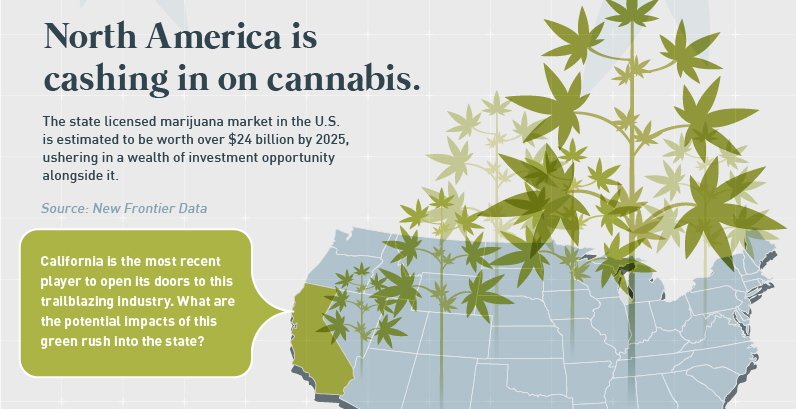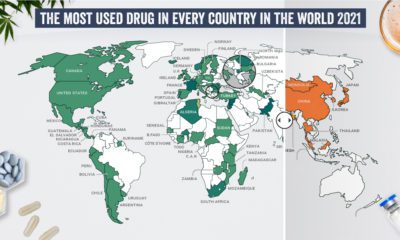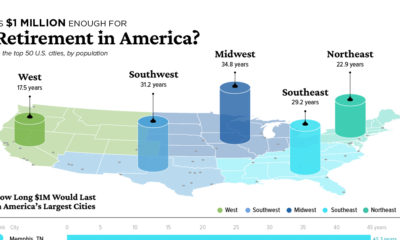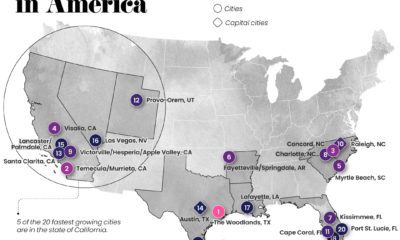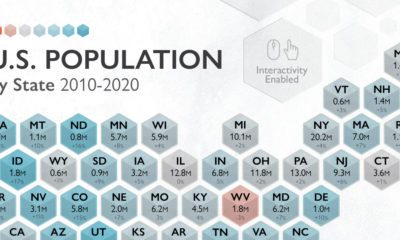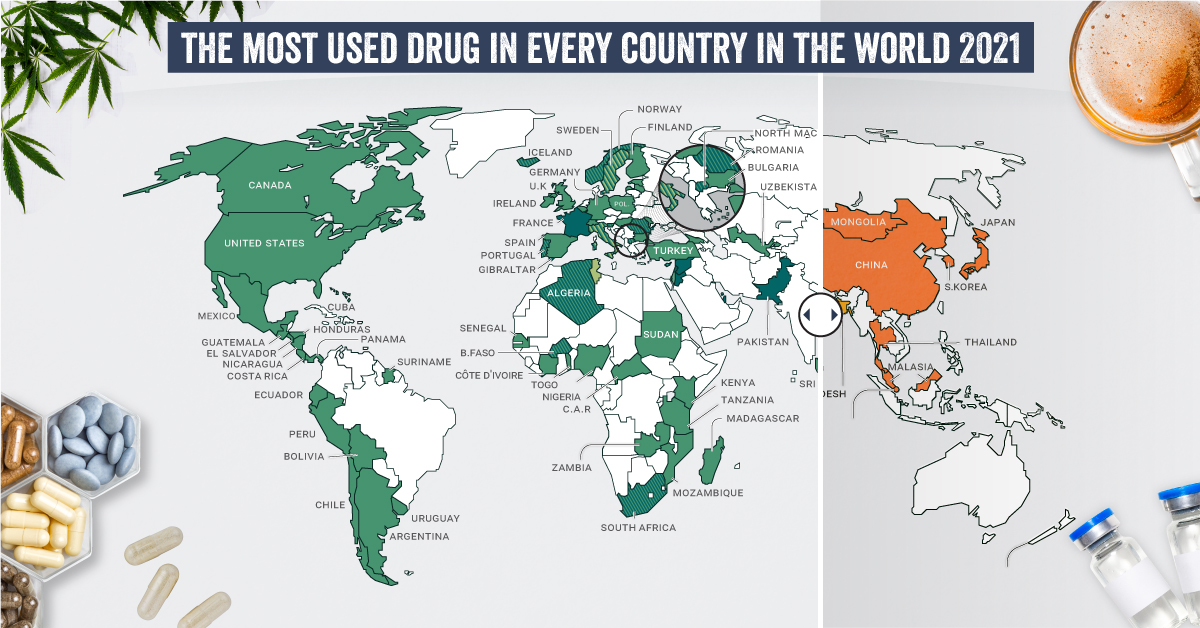The legalization of cannabis for adult use – first passed in the states of Washington and Colorado in 2012 – is now approved in a total of nine states and the District of Columbia. By the end of the year, that total could be in the mid-teens as states vote on cannabis-related ballots in the upcoming mid-term elections.
California’s Green Rush
States are legalizing the adult use of cannabis for various reasons, but there’s no doubt that one of the primary ones is the potential impact on both the economy and government coffers. Today’s infographic comes from cannabis royalty company FinCanna Capital, and it helps to contextualize the possible effects of cannabis legalization on the country’s largest state economy: California.
Experts say the current cannabis market (including unregulated sales) in California is already worth about $8.5 billion, making cannabis quite the cash crop to start with. In fact, it’s an amount that’s bigger than the current three largest agricultural markets in the state: milk and cream ($6.1B), grapes ($5.6B), and almonds ($5.2B). With the passing of Proposition 64 in November 2016 and legalization officially taking effect January 1, 2018, the state of California is now the world’s largest regulated cannabis market. To take advantage of this growing opportunity, entrepreneurs are rushing to the Golden State from far and wide.
Sizing Up the Green Rush
In 2016, the regulated market for cannabis, which only included medical marijuana at the time, was worth $2.81 billion in California. However, Arcview Market Research predicts that California will see regulated sales grow at a 23.1% annual pace between 2016-2020 as adult use sales come into play. By 2020, the total regulated industry will be worth $6.5 billion. Meanwhile, it’s expected that the state government will be pocketing from the rush as well, picking up $1 billion or more per year from taxes. That includes a 15% levy on all cannabis sales, as well as cultivation taxes applied to buds and trimmings.
The Medical Component
As the largest legal market on the planet, California could see less expected green shoots, as well. Because of its federal classification as a Schedule I substance, cannabis is extremely under-researched globally. With wider state acceptance of cannabis in California, it may be possible to foster an environment where more could be learned about the vast medical potential of the plant through the state’s powerful universities and institutions. This could lead to increased innovation, investment, and medical discoveries that could have an additional economic impact. Such a track would follow in the footsteps of Israel, which is the world’s leader in marijuana research. In the country, there are 120 ongoing studies, $100 million in foreign and U.S. funds invested into patents, startups, and delivery devices, and ten-fold growth in investment expected between 2017-2019.
on Humans have a storied and complicated relationship with drugs. Defined as chemical substances that cause a change in our physiology or psychology, many drugs are taken medicinally or accepted culturally, like caffeine, nicotine, and alcohol. But many drugs—including medicines and non-medicinal substances taken as drugs—are taken recreationally and can be abused. Each country and people have their own relationship to drugs, with some embracing the use of specific substances while others shun them outright. What are the most common drugs that are considered generally illicit in different parts of the world? Today’s graphics use data from the UN’s World Drug Report 2021 to highlight the most prevalent drug used in each country.
What Types of Common Drugs Are Tracked?
The World Drug Report looks explicitly at the supply and demand of the international illegal drug market, not including commonly legal substances like caffeine and alcohol. Drugs are grouped by class and type, with six main types of drugs found as the most prevalent drugs worldwide.
Cannabis*: Drugs derived from cannabis, including hemp. This category includes marijuana (dried flowers), hashish (resin), and other for various other parts of the plant or derived oils. Cocaine: Drugs derived from the leaves of coca plants. Labeled as either cocaine salts for powder form or crack for cocaine processed with baking soda and water into rock form. Opioids: Includes opiates which are derived directly from the opium poppy plant, including morphine, codeine, and heroin, as well as synthetic alkaloids. Amphetamine-type Stimulants (ATS): Amphetamine and drugs derived from amphetamine, including meth (also known as speed), MDMA, and ecstasy. Sedatives and Tranquilizers: Includes other drugs whose main purpose is to reduce energy, excitement, or anxiety, as well as drugs used primarily to initiate or help with sleep (also called hypnotics). Solvents and Inhalants: Gases or chemicals that can cause intoxication but are not intended to be drugs, including fuels, glues, and other industrial substances.
The report also tracked the prevalence of hallucinogens—psychoactive drugs which strongly affect the mind and cause a “trip”—but no hallucinogens ranked as the most prevalent drug in any one country. *Editor’s note: Recreational cannabis is legal in five countries, and some non-federal jurisdictions (i.e. states). However, in the context of this report, it was included because it is still widely illicit in most countries globally.
The Most Prevalent Drug in Each Country
According to the report, 275 million people used drugs worldwide in 2020. Between the ages of 15–64, around 5.5% of the global population used drugs at least once. Many countries grouped different types of the same drug class together, and a few like Saudi Arabia and North Macedonia had multiple different drug types listed as the most prevalent. But across the board, cannabis was the most commonly prevalent drug used in 107 listed countries and territories: How prevalent is cannabis worldwide? 72 locations or more than two-thirds of those reporting listed cannabis as the most prevalent drug. Unsurprisingly these include countries that have legalized recreational cannabis: Canada, Georgia, Mexico, South Africa, and Uruguay.
How Common Are Opioids and Other Drugs?
Though the global prevalence of cannabis is unsurprising, especially as it becomes legalized and accepted in more countries, other drugs also have strong footholds. Opioids (14 locations) were the most prevalent drugs in the Middle-East, South and Central Asia, including in India and Iran. Notably, Afghanistan is the world’s largest producer of opium, supplying more than 90% of illicit heroin globally. Amphetamine-type drugs (9 locations) were the third-most common drugs overall, mainly in East Asia. Methamphetamine was the reported most prevalent drug in China, South Korea, and Japan, while amphetamine was only the most common drug in Bangladesh. However, it’s important to note that illicit drug usage is tough to track. Asian countries where cannabis is less frequently found (or reported) might understate its usage. At the same time, the opioid epidemic in the U.S. and Canada reflects high opioid usage in the West. As some drugs become more widespread and others face a renewed “war,” the landscape is certain to shift over the next few years.

